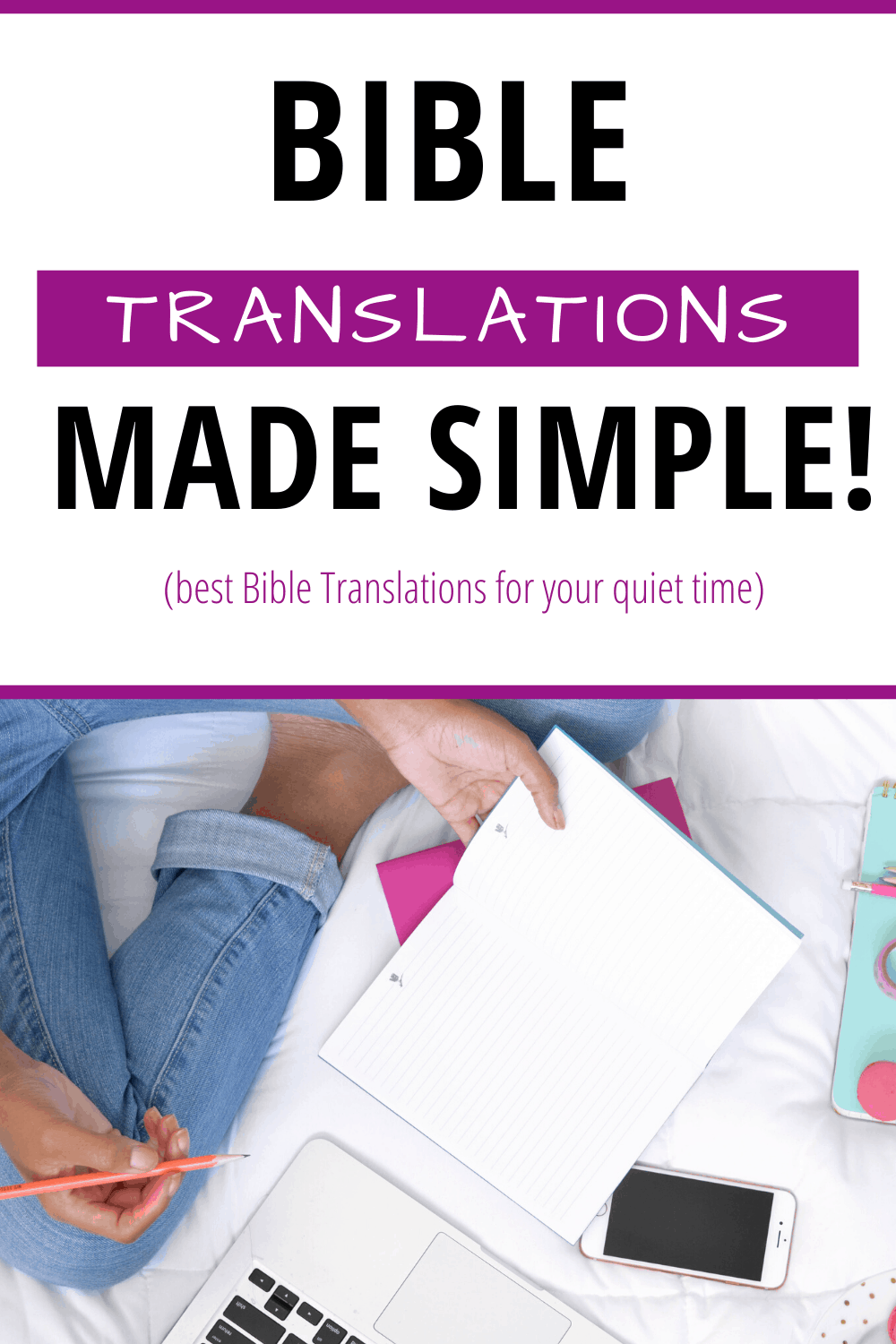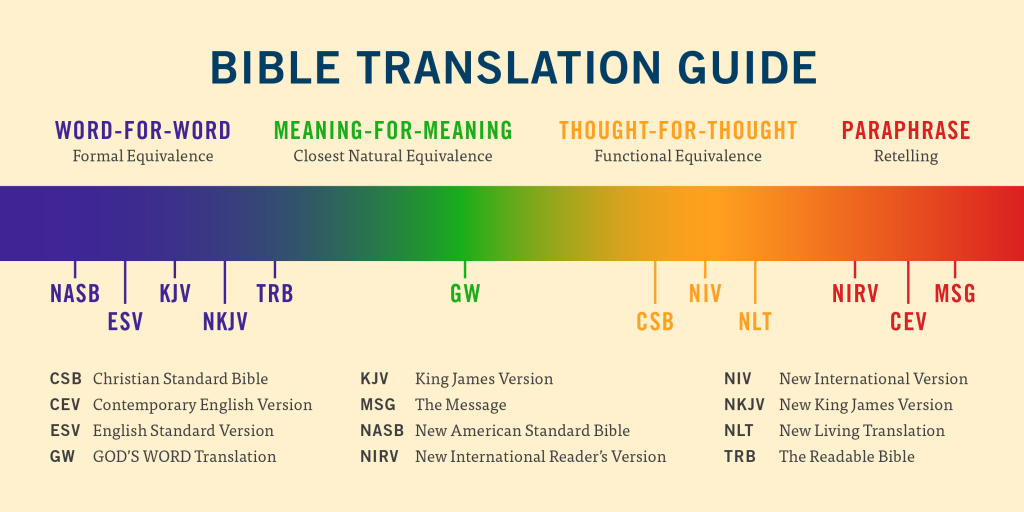What is the Most Accurate Bible Translation?


Looking for the most accurate Bible translation? For new Christians choosing a Bible translation can be an overwhelming task with the sheer number of versions available.
This abundance of choices can be both exciting and overwhelming, leaving you wondering which version to choose and how it will impact your understanding of God’s Word.
Whatever your preferred way to study the Bible, you can likely find a Bible that matches your interest. Take for example this verse mapping Bible which is perfect for those who love to dig deeper into God’s words through verse mapping.
As a new Christian, you may be wondering, why there are so many translations, which one is the most accurate, and if there are any to avoid.
What is the most accurate translation of the Bible in the world?
What version of the Bible is easiest to Understand?
Which translation of the Bible is closest to the original text?
If you are pondering these questions, then this guide is for you. In this article, we aim to provide clarity and guidance to help you make an informed decision when selecting a Bible translation for your Bible study.
This post may contain affiliate links. You can read my full affiliate disclosure here.
Why are There so Many Bible Translations?
The Bible wasn’t written originally in English, but you likely already know that. Portions of the Bible was written in Hebrew, while other sections in Aramaic and Greek. Since most of us can’t read these original languages, we have to rely on Bible scholars to do the translations for us.
Shouldn’t that be easy, you may ask? Well not quite, as there is way more to language translation than just translating individual words.
Things such as grammatical structure and context play a big role in translating from one language to another to help convey your intended message.
The reason behind the existence of numerous Bible translations is rooted in the diverse nature of our global world, encompassing a vast array of languages, cultures, and dialects. Even within the English-speaking community, there are variations in language usage.
For instance, individuals residing in the United States employ a slightly different form of English compared to those in the United Kingdom. Therefore, the availability of different Bible translations caters to the unique needs of cultures around the world making it accessible to them in modern English in a way that they can understand.
Furthermore, ongoing scholarly research continually deepens our understanding of the biblical languages. As scholars uncover new insights, translations may choose to make updates or do revisions as well.
The King James Bible Debate
The debate surrounding Bible translations, particularly the King James Version (KJV) and modern versions, has raised questions about their reliability and validity. The “KJV Only” movement claims that the KJV is the only trustworthy translation, while modern versions are believed to be corrupted.
Modern translations are based Codex Vaticanus and the Codex Sinaiticus manuscripts, which are older manuscripts. In this case however, older may not always be better.
These manuscripts have a large number of corrections written over the text. In fact, the Codex Sinaiticus was found in 1859 in the Monastery of St. Catherine in a dump. While the King James Version is based another stream of manuscripts the Textus Receptus.
Textual critics assert that manuscripts should be the standard, not a particular translation. The absence of certain chapters and verses in modern translations cannot be used as an argument because those numbers were added to the Bible during the Middle Ages.
Instead of verses and phrases being removed or altered in modern versions, evidence suggests that the KJV contains expanded text. Some may have been marginal notes added by copyists for clarification, while others might have aimed to harmonize passages with other scriptural sections.
The variants found in Bible manuscripts do not alter any of our doctrines. Even if we had only Erasmus’ Greek New Testament, we would still possess an exceptionally well-preserved Bible that we can confidently affirm as the Word of God.
Most Accurate Bible Translation – Best Bible Translation
In deciding on a Bible, there are three Bible Translations types that you will come across, these include: word for word Bible translations, thought for thought Bible translations and paraphrase Bible translations.
If you find that you are struggling to understand what you are reading when studying the Bible, I would encourage you to explore different Bible Translations. You can get a feel for different versions by simply navigating to different Bible translations available in the YouVersion Bible app. Try different versions until you find a version that you are comfortable with.
Personally, I use a different version depending on what I am trying to accomplish. For everyday reading I use the Christian Standard Bible, however if I am studying a text or want to do a comparative look at a text, I will resort to the New King James Version.
You are welcome to do something similar or just choose a version that you enjoy reading. The key is that you are in the word regularly and focusing on building your relationship with God. Let’s take a look at the best translation available along with examples of Bible translations that would fall into those categories.

Word-For-Word Translation of the Bible
Word for Word Bible translations are also known as Formal Equivalence or literal translation. In Word for word translations, language scholars try to retain the general structure and form of the original language while providing word for word translations as much as possible. By staying close to the original words and grammatical structure, they reduce the human interpretation factor.
Some prominent word for word Bible translations include:
- American Standard Version
- King James Version
- New King James Version
- Young’s Literal Translation
- The Amplified Bible
- English Standard Version
- New Revised Standard Version
- New American Standard Bible
Thought-For-Thought Translation of the Bible
Thought for Thought translations are also known as dynamic equivalence. Thought for Thought Bible translators try to approach language translation by looking at the essential meaning of text by the original authors.
This makes these versions easy to read and understand as lesser known metaphors known to modern readers are usually rephrased.
The challenge with dynamic equivalence is that in an effort to convey the meaning of the text, if translators misinterpret the authors original intent then this misunderstanding will also be communicated unintentionally to those who read that translation.
Some prominent thought for thought Bible translations include:
- New International Version
- New Living Translation
- Christian Standard Bible
Paraphrase Translations of the Bible
Paraphrase Translations try to convey the authors intended meaning using modern phrases and metaphors. The aim of this translation is to make it appeal to modern audiences by using modern language that captures the essence of the Biblical text giving the reader clarity.
Some prominent paraphrase Bible translations include:
- The Message
- The Living Bible
- The Clear Word
Which Bible Version is the Easiest to Understand?
Now that we have compared different Bible translations lets look at a side by side translation of the different translations using a very famous Bible passage, John 3:16-18.
“This is how much God loved the world: He gave his Son, his one and only Son. And this is why: so that no one need be destroyed; by believing in him, anyone can have a whole and lasting life. God didn’t go to all the trouble of sending his Son merely to point an accusing finger, telling the world how bad it was. He came to help, to put the world right again. Anyone who trusts in him is acquitted; anyone who refuses to trust him has long since been under the death sentence without knowing it. And why? Because of that person’s failure to believe in the one-of-a-kind Son of God when introduced to him.” ~~The Message
“For this is how God loved the world: He gave his one and only Son, so that everyone who believes in him will not perish but have eternal life. God sent his Son into the world not to judge the world, but to save the world through him. There is no judgment against anyone who believes in him. But anyone who does not believe in him has already been judged for not believing in God’s one and only Son.” ~~New Living Translation
“For God so loved the world that He gave His only begotten Son, that whoever believes in Him should not perish but have everlasting life. For God did not send His Son into the world to condemn the world, but that the world through Him might be saved. “He who believes in Him is not condemned; but he who does not believe is condemned already, because he has not believed in the name of the only begotten Son of God. ” ~~ New King James Version
From the above verses, you can see that the New King James Version along with the New Living Translation are relatively similar. The Message translation however while easy to read, it conveys a different perspective of the passage.
What Are the Most Popular Bible Translations
Now that you understand what the different Bible Translations are, lets explore some of the most popular Bibles for different Bible Translations on the market.
CSB She Reads Truth Bible
The CSB She Reads Truth Bible is the Bible I use and adore. It is beautifully crafted to encourage women to dive into the word of God. It includes 200 devotionals, reading plans, maps, charts and timelines along key verses beautifully crafted. Beautifully crafted to help women look forward to their time spent in the word. They also have a He Reads Truth Bible geared towards men.
Holman NKJV
The Holman Study Bible is an award winning study Bible for women and men. It includes book introductions and study notes that helps to give readers context of the book that they are about to read. This Bible also comes with 15,000 study notes. What I really like about this Bible however is that it is filled with illustrations, photos, maps and charts which help to bring your study time to life.
NASB Thinline Bible
NASB Thinline Bible is a literal word for word Bible translation. It comes with a concordance along with articles that dive into the ministry of Jesus, promises of the Bible for various topical life situations.
Interlinear
The Interlinear Bible is a literal translation of the Bible. It includes the Hebrew and Greek texts along with the direct English language translation. You don’t need to know Hebrew or original Greek to read this Bible. The side by side translations however make this perfect for comparative study.
NLT Illustrated Study Bible
The NLT Illustrated Study Bible was awarded Bible of the year in 2016. Similar to other Study Bibles mentioned above, it includes study notes, illustrations, maps and photos to give readers a visual study experience of the scriptures.
NIV Beautiful Word Bible
If you are into Bible Journaling, The NIV Beautiful Word Bible is the Bible for you. It includes ready to color line art that helps you meditate on scripture as you color in the scripture art.
Which Bible Version is Best For You?
Compare Bible Translations to Find the One That Works for You! I hope you found this Bible Translation Comparison helpful as well as found suggestions for the most accurate Bible translations that you can add to your quiet time. I would love to know your thoughts in the comments below, which version of the Bible do use the most and why?
ADDITION BIBLE TRANSLATION COMPARISON POSTS YOU MAY LIKE
Is the Bible true? 5 Powerful Reason to Trust The Bible
How to Study The Bible For Yourself







I completely agree with the author’s conclusion that the most accurate Bible translation is a matter of interpretation and personal perspective. I have read several translations and have found that each one has its own strengths and weaknesses. Ultimately, I believe that the most important thing is to find a translation that resonates with your own spiritual beliefs and understanding of the text. Great post!
This was an enlightening post! I appreciated the breakdown of different translations and their unique approaches to accuracy. It really makes you think about how the nuances in language can affect our understanding of scripture. I’d love to hear more about how to choose a translation for personal study!